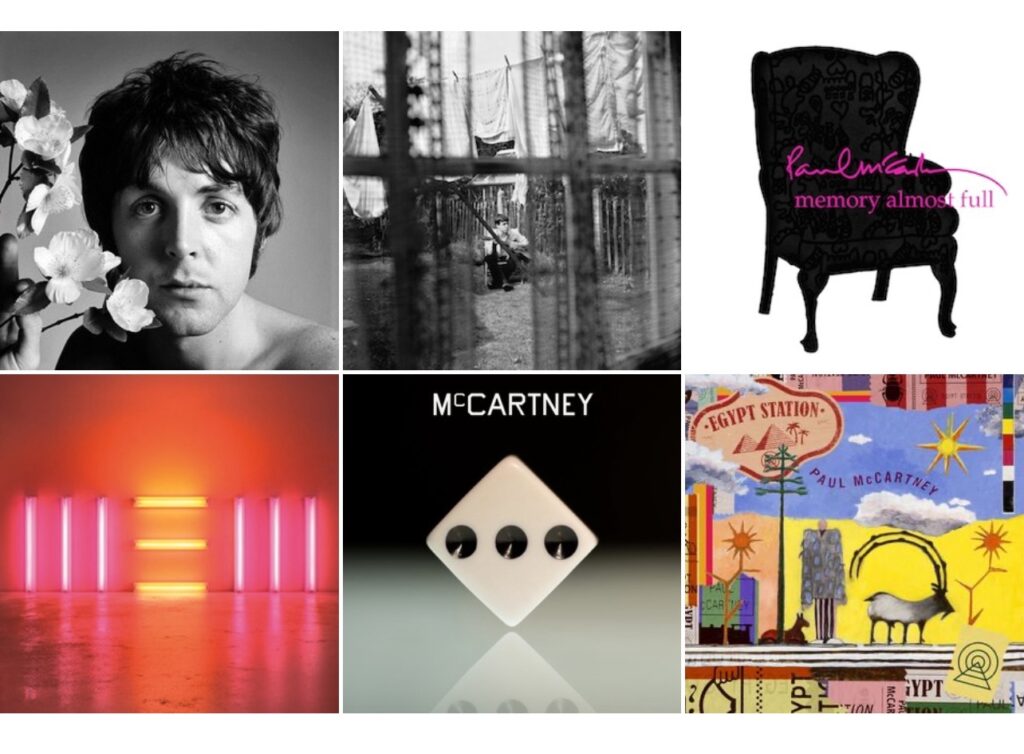
As I was watching Los Angeles burn last week, I felt a deep, unshakeable crumminess. The flames seemed to carry with them a weight of history, of loss, and of survival itself. It was in that moment that the last few Paul McCartney albums I had been listening to—albums I hadn’t given much thought to—suddenly revealed an incredible, meaningful tone. It was as if they were shaped by a form of survivor’s guilt, an emotional undercurrent that, in the wake of such devastation, made everything fall into place. It all made sense.
Thinking of Paul McCartney’s last five albums through this lens reveals fascinating layers of existential tension and sublimated emotion. McCartney’s work can be read not merely as the output of a pop-cultural survivor but as a persistent dialogue with his past, his losses, and the historical weight he carries as the last towering figure of the Beatles still actively producing.
1. Chaos and Creation in the Backyard (2005)
Chaos and Creation seems an attempt by McCartney to confront the Real of his past—the trauma of Lennon’s murder, Harrison’s death, and the slow disappearance of the utopian ideal embodied by the Beatles. The album’s melancholic tone, exemplified by tracks like “Jenny Wren” and “Too Much Rain,” represents McCartney’s negotiation with guilt over being the one left behind. Yet, as I would argue, McCartney resists direct confrontation with loss through his meticulous craftsmanship. The album becomes a “sublime object of ideology,” wherein McCartney packages grief in the form of soothing melodies, as if to reassure himself and the world that beauty can still arise from ashes. We might quip that McCartney represses the traumatic kernel of survival, giving us an overly polished jewel that hides its cracks too well.
2. Memory Almost Full (2007)
This album is haunted by the specter of mortality and the burden of remembrance. Tracks like “The End of the End” and “Vintage Clothes” evoke a self-reflective McCartney, confronting his legacy with a smile that we could call “a mask of hysterical denial.” Survivor’s guilt manifests here as a preoccupation with legacy—McCartney’s playful nostalgia is tinged with a deep anxiety: how to sustain the myth of the Beatles while resisting the commodification of their memory? We might argue that this album represents McCartney’s struggle with symbolic death—the death of his mythos—rather than physical death. By transforming his survivor’s guilt into the playful irony of “Dance Tonight,” McCartney performs what its called the “fetishistic disavowal”: he knows he is mortal, but he acts as though he is not.
3. New (2013)
Here, McCartney’s survivor’s guilt morphs into a desperate vitality, we might suggest, as if McCartney is saying: “Yes, I am still here, and I still matter!” Tracks like “Queenie Eye” and “New” play with youthful energy, but this energy itself is suspect—it is a frantic act of jouissance, a surplus enjoyment meant to stave off the realization of the void left by his lost companions. We could argue that the optimism of New is fundamentally performative, a gesture to mask the fact that McCartney’s very existence is a painful reminder of what has been lost. The album becomes, paradoxically, a celebration of survival that highlights the impossibility of truly enjoying it.
4. Egypt Station (2018)
Egypt Station is a further articulation of McCartney’s attempt to confront survivor’s guilt through displacement. Tracks like “Happy with You” present a pastoral fantasy of simplicity, but this simplicity is ideological—an escape from the complex network of historical and personal guilt. McCartney is caught between his desire to move forward and the weight of his past, and this tension creates a fragmented narrative. Egypt Station, like New, pretends to move forward while always looking back, a perfect symptom of repression.
5. McCartney III (2020)
McCartney III is the ultimate encounter with the void of survival. Recorded in isolation during the COVID-19 pandemic, the album strips back the layers of production, leaving McCartney alone with his thoughts and his instruments. Tracks like “Winter Bird / When Winter Comes” encapsulate the stillness and solitude of a survivor reflecting on his life. This return to minimalism is not merely a stylistic choice but a confrontation with the Real—the inescapable awareness of his finitude and the haunting absence of those who shaped his journey. The album becomes an elegy to survival itself, the quiet acceptance of guilt and gratitude intertwined.
Objects of sublimation
McCartney’s last five albums are pearls of survivor’s guilt precisely because they oscillate between denial, displacement, and confrontation. Each album, in its own way, is a fetishistic object, transforming McCartney’s unresolved trauma into something palatable for mass consumption. Yet beneath the polished surface lies a profound and unarticulated scream: Why me? Why am I the one left standing? McCartney’s work thus becomes a paradoxical testament to survival—both a celebration of resilience and an admission of its impossibility.
The meticulous production and polished arrangements act as a kind of defensive shield, sublimating grief into something beautiful but controlled. This beauty, however, is a kind of lure. It invites us to engage with the albums emotionally while simultaneously masking the full intensity of its underlying anguish. In this way, the albums become what one might call a “sublime object”—a creation that conceals its void, its lack, by presenting itself as whole and coherent. McCartney’s grief, rather than being directly confronted, is transformed into an aestheticized version of itself, smoothed over by melody and craft.
Yet, this very polish betrays its own repression. The excess care put into the album—its arrangements, its meticulousness—points to an unspoken fear: the possibility that, without this artistry, the fragile framework holding back the chaos might collapse. The melancholic tone, then, is not a direct expression of loss but a mediated one, carefully framed to avoid the destabilizing force of what cannot be fully symbolized. The listener is drawn into this dynamic, encountering not only the traces of McCartney’s grief but also the ways in which it is disguised, reshaped, and contained.